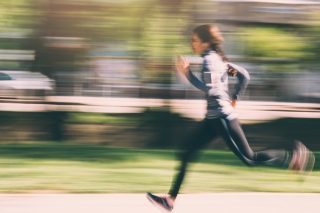6 Ways to Become a Faster Runner Without Running a Step

There are plenty of things you can do to get faster without running a step. Photo: iStock
Runners are a hardworking lot, so the promise of “free speed” often strikes us as empty, and maybe even a touch offensive. However, once you get runners talking about improvements they have made in their training, gear or diets, they are usually eager to share the discoveries that have helped improve their performances. That’s the goal with this article—to share some well-documented techniques that could help you get faster, beyond than the obvious (and undeniably effective) advice to run more miles and train harder.
Wear Lighter Shoes
Researchers have established that the reducing shoe weight by 100 grams typically yields about a 1 percent increase in performance. That’s a pretty big gain that could be especially noticeable over longer distances. However, like most of the tips in this guide, there are some limitations to keep in mind—not every runner will benefit from switching to racing flats or other super-light shoe models. If the cushioning or shoe stability is inadequate you will lose efficiency and give back any potential performance gains.
RELATED: Are Racing Flats Right for You?
Get a Proper Warm-up
“Ninety percent of success in running comes down to a willingness to work hard and sacrifice, and being consistent,” Coach Alan Culpepper recently wrote. “The other 10 percent comes down to areas like diet, hydration, stretching and injury prevention. A proper pre-run warmup routine is part of that 10 percent. It might seem inconsequential, but it can make or break a race or hard workout.” Read Coach Culpepper’s warmup advice here, and check out the link below for info on a dynamic warmup that researchers say can improve performances.
RELATED: The Mattock Dynamic Warm-up for Runners
Lose Unwanted Bodyweight
Like our first tip about the potential speed gains from reducing shoe weight, it’s proven that reducing excess bodyweight can help make runners faster—but only to a point. “Each runner has an optimal racing weight,” writes Matt Fitzgerald, the author of Racing Weight, How to Get Lean for Peak Performance. “I define this as the weight at which a runner performs best in races. Because runners are more often above their optimal racing weight than right at it, they tend to associate losing weight with gaining performance. This association leads some runners to make weight loss their primary focus and to push performance into the background.” Simply put, losing a few pounds could make you faster, but losing too much weight will make you slower, and potentially lead to other health issues.
RELATED: For Runners, Not All Weight Loss is Good Weight Loss
Add Plyometric Exercises
We said we could make you faster without running more, but we didn’t say anything about adding leaping, bounding and jumping to your training. Multiple studies have shown that adding plyometric exercises to runners’ normal routines produces gains in both speed and endurance. The speed part makes sense intuitively—the explosive nature of plyometrics clearly translates to better top-end running speed. But keep in mind that as your explosive power increases your running economy and endurance usually improves too.
RELATED: The Benefits of Plyometrics for Runners
Crank Up the Tunes
Another point that running researchers agree on is that there is a sweet spot of about 180 steps per minute that most elite runners meet or even exceed. A faster cadence leads to better efficiency and reduces the chance that you are overstriding. So, how do you boost your running cadence toward this mark? Try making playlist with songs like the 15 tunes featured in the article below—they will pace your footsteps with 180 beat-per-minute rhythms.
RELATED: How Music Can Boost Your Cadence
Stop Running
Perhaps you clicked on this story because you’re feeling a bit desperate to get faster. You’re hitting your target mileage, and sometimes more, every week. You give your all in speed work and other demanding training sessions, but without seeing the results you’re hoping to achieve. If those scenarios sound familiar you are a prime candidate for becoming overtrained. “While the signs and symptoms of overtraining aren’t overt, it is possible to identify which activities present the greatest danger to overtraining, recognize subtle signs that suggest you’re approaching the precipice, and discuss how to come back if you believe you are overtrained,” writes running coach and author Jeff Gaudette in the article below.
RELATED: Overtraining: Why It Happens, How To Spot It and How To Dig Yourself Out
The post 6 Ways to Become a Faster Runner Without Running a Step appeared first on Competitor.com.
Ryan Hall's Blog
- Ryan Hall's profile
- 21 followers



